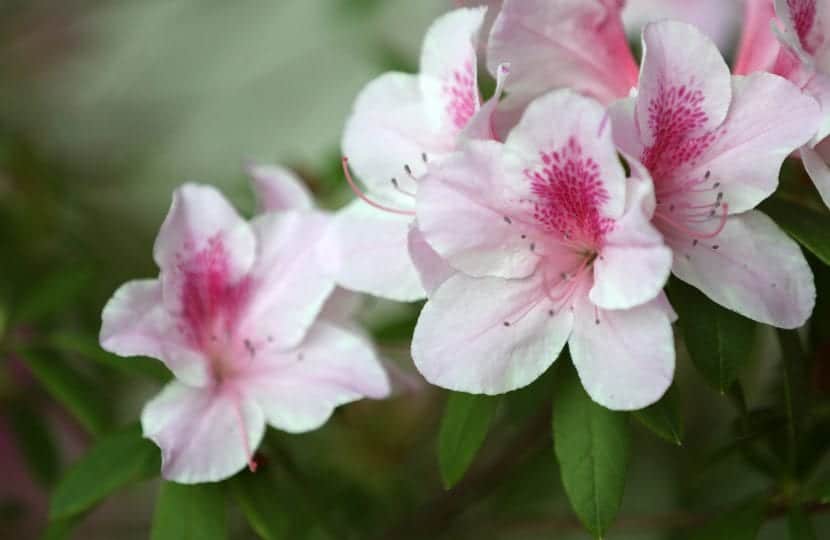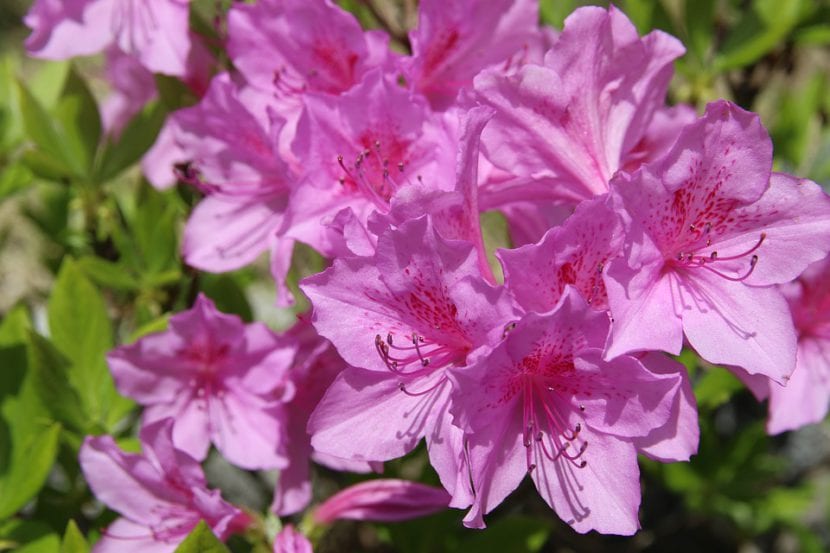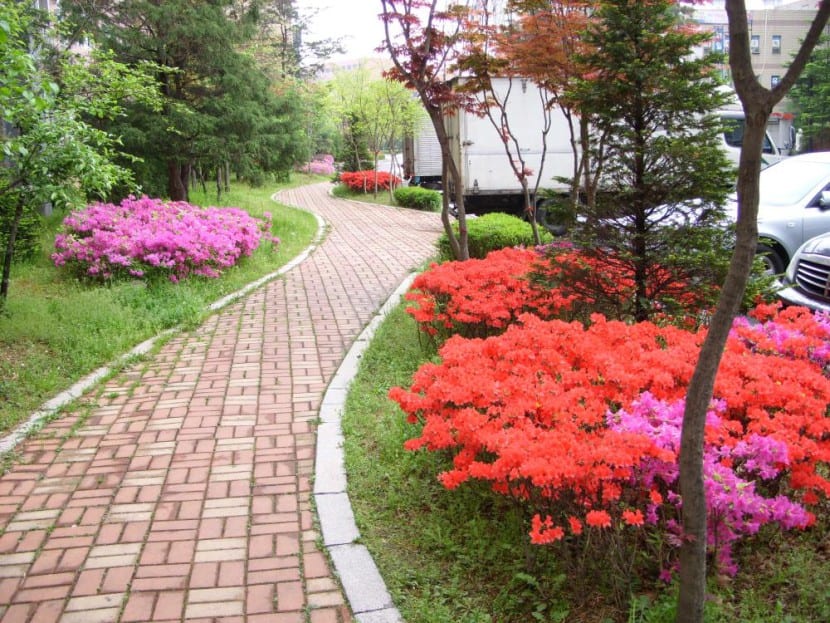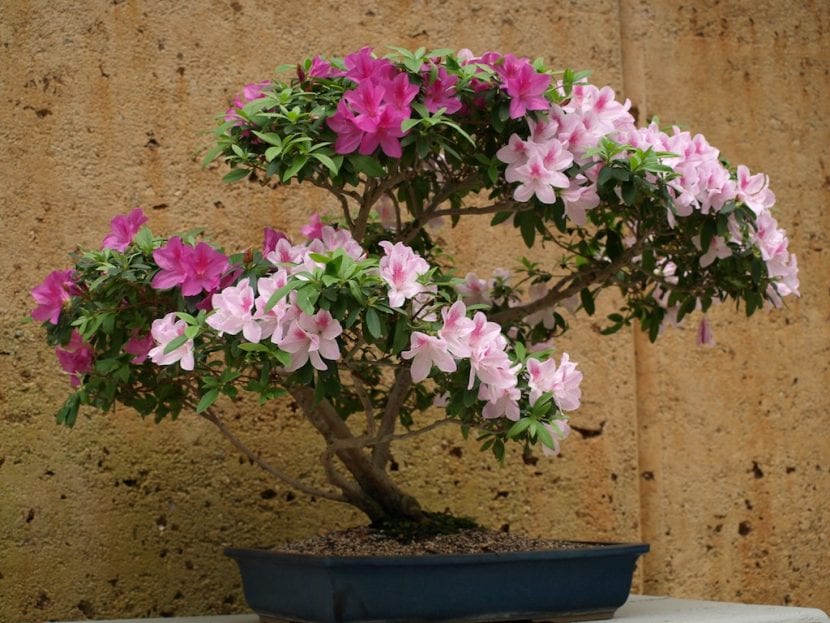
La azalea It is one of the bushes preferred by people. It produces so many flowers in the spring that the leaves are often hidden behind the delicate and beautiful petals. In addition, due to its characteristics, it is often grown in pots to decorate the balcony or terrace, or even as a bonsai.
It is, therefore, one of the most interesting species that can have both the amateur gardener and the one who has just debuted in the world of gardening.
Knowing the azalea

While it is a plant native to East Asia, the azalea has been able to adapt and today grows without problems in temperate regions of the world. Its scientific name is Rhododendron indicum and it is a perennial plant (that is, it looks evergreen) that belongs to the family of the Ericaceae.
It is distinguished from others by its small green leaves of just 1cm in length that even without flowers are pleasant in any season, bright and of great resistance. When it blooms towards spring, the best happens because then its beautiful flowers appear, which are grouped and form a colorful network. They are large and generous, and although the pink color is the most characteristic also there are white, orange and red flower azaleas.
This plant can reach a size of up to two meters if it is grown on land, although the most common is that it acquires an average height of half a meter.
Care and recommendations

If you want to have one or more copies, then we are going to give you a care guide so you can enjoy your azalea during years:
Location
It has to be put in the Exterior, in semi-shadow. Ideally, you should give them indirect sunlight, as they do not grow well in shady places.
Soil or substrate
It is important that, regardless of whether it is in a pot or in the garden, the soil is acidic with a pH of 4 to 6, with good drainage. In calcareous lands its leaves turn yellow soon due to the lack of nutrients, mainly iron and manganese.
Although you can lower the pH by watering with water with lemon (½ lemon diluted in 1l of water) and making fertilizer with fertilizers for acid plants, it is better not to risk it and plant it in those lands that are suitable for it from the first moment.
Irrigation
Must be frecuente, especially during the summer. Of course, we must avoid extremes: he does not like to have dry "feet", but neither are they waterlogged. To know when to water, simply insert a thin wooden stick (if it comes out clean, we can water since the soil will be dry), use a digital moisture meter or weigh the pot once watered and again after a few days (this difference in weight can serve as a guide to know when to water).
You have to use rainwater, without lime or water with lemon.
Subscriber
In spring and summer It must be paid with a fertilizer for acid plants (you can buy it here), following the indications specified on the package. It can also be paid in autumn if you live in an area with a mild climate, with light frosts.
Planting or transplanting time
In spring, when the risk of frost has passed.
Pruning
If required, overgrown stems can be trimmed in autumn, as well as the withered flowers.
Pests

It can be attacked by:
-
Trips: they are insects similar to earwigs but with a size of 1cm. They adhere to the underside of the leaves, from where they feed. They can be seen with the naked eye, both them and their droppings (they are like black dots).
To eliminate them, the leaves can be cleaned with a wipe or ear swab moistened with lime-free water, or by treating the affected specimens with Chlorpyrifos. -
Red spider: these mites also adhere to the underside of the leaves. They can be seen with a magnifying glass. You can tell if they have if we see cobwebs.
To eliminate them, they can be treated with neem oil or cleaning the leaves with lime-free water.
Management
If overwatered they may have mushrooms. Must control the risks and do preventive treatments in spring and autumn with sulfur or copper. During the summer they will be treated with spray fungicides.
Multiplication
Azaleas multiply by seeds, cuttings, and layering. Let us know how to proceed in each case:
Seeds
The seeds they have to be sown in a seedbed in spring, using a substrate for acidic plants (you can buy it here) or vermiculite. They must be placed on the surface, leaving a distance of 1-2cm between them, and keep the substrate moist.
Will germinate out of 1-2 months.
Cuttings
To obtain new azaleas that are identical to the mother plant branches of at least 30cm in length should be cut in spring. Then the base is impregnated with rooting hormones and planted in pots with porous substrates, such as kanuma.
Keeping it moist will root after about 2 months.
Layered
If we want to layer it, we must do it in spring, making a 1-2cm ring or ring without bark. This ring has to be infused with rooting hormones, since it is where the new roots will come out.
Next, a black plastic bag is taken and tied at one end and then filled with substrate for acidic plants, and finally be tied to the mother plant at the other end.
With a syringe, you have to keep the soil moist. A) Yes, will root after 2-3 months. When that happens, we can cut our new plant and plant it in a pot or in the garden.
Rusticity
The azalea supports frosts of up to -3ºC.
How do you care for azalea bonsai?

If what you want is an azalea bonsai that is beautiful all year round, follow our advice:
-
Location: outside, in semi-shade.
-
Irrigation: frequent, preventing the substrate from drying out completely. Use lime-free water.
-
Substratum:kanuma.
-
Styles: indifferent. It fits well with everyone, although it is especially pretty when given a formal upright or waterfall look.
-
Subscriber: in spring and summer it must be paid with bonsai fertilizer, following the instructions specified on the packaging.
-
Pruning: only if you are healthy. Branches that have grown excessively in early fall, and wilted flowers, should be trimmed. Formation pruning should be done in late winter.
-
Transplant: every 2 or 3 years in spring, after flowering.
-
Wiring: in spring and summer.
What did you think of the azalea? You have someone?
Hello Monica,
I was thinking of planting an azalea in a glass and under it a dwarf ivy ... I do not know if this combination is possible due to nutrients and soil acidification.
If you can't tell me what could I plant with the ivy? The pot seems very bland to me.
Thank you very much.
Hi Esther.
Ugh, difficult combination that you propose. Ivy grows very fast, and could potentially drown azalea unless you kept it at bay. Don't worry about pH, as ivy tolerates slightly acidic soils (pH 5-6), which is just what azalea needs.
Regards!